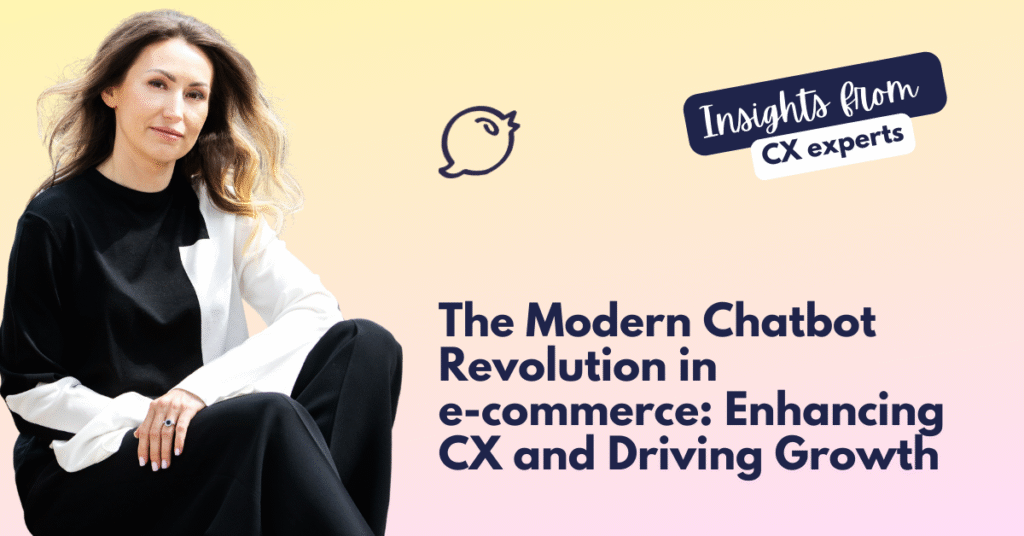The Modern Chatbot Revolution in E-commerce: Enhancing CX and Driving Growth

Sandra Roosna
Askly CEO & Founder

Shopping online today looks nothing like it did five years ago. Back then, you’d scroll endlessly, add to cart, hit checkout… and if you had a question, you’d either hunt for a support email or hope someone picked up the phone.
Fast forward to 2025, and things have changed dramatically. Customers expect instant answers, personalized product suggestions, and even post-purchase hand-holding. And the secret behind this shift? AI-powered chatbots.
But let’s be clear: these aren’t the clunky bots of the past that spit out generic FAQs. The modern chatbot has become a kind of “digital concierge,” guiding customers through every step of the journey, whether it’s helping them choose a skincare product on Instagram or resolving a delivery hiccup at midnight.
So, how exactly are they reshaping e-commerce? And what should businesses, small or large, really know before jumping in to avoid having “another annoying chatbot” on their website?
Let’s break it down.
From Luxury to Necessity: Why Chatbots Are Everywhere and Most are Annoying?
Not long ago, chatbots were considered a “nice-to-have,” something tech-forward companies experimented with. Today, they’re business-critical. Gartner recently reported a surge in chatbot adoption among small and mid-sized businesses, not just enterprise giants. Why? Because they scale customer support without scaling headcount.
Think about a boutique retailer selling handmade jewelry. Two years ago, they might have spent hours each week responding to basic questions: Do you ship internationally? How long does delivery take? Can I track my order? Now, a chatbot can answer all of that instantly, 24/7. That time saved translates directly into growth because the founder can focus on designing and marketing instead of playing customer service rep.
In fact, some studies show that AI chat solutions can reduce service costs by up to 30% while boosting sales conversions fourfold. That’s not a “future prediction”. That’s happening right now.
What Makes a Chatbot Actually Useful?
Here’s the thing: not all bots are created equal. We’ve all experienced frustrating ones: the kind that loop you in circles until you give up. So what separates the winners from the flops? A few key ingredients:
- Real conversation, not canned replies. Modern bots use advanced natural language processing (NLP) to actually “get” what customers are asking, instead of just matching keywords.
- Seamless social integration. Customers hang out on Instagram, WhatsApp, TikTok. The best bots meet them where they are, not just on a brand’s website.
- Personalization that feels human. Imagine browsing a skincare brand’s Instagram, and a chatbot pops up saying, “Noticed you’ve been checking our vitamin C serums—want me to compare them for you?” That kind of detail builds trust.
- Data-driven learning. Great bots improve with every interaction. They don’t just answer questions—they learn from patterns to refine responses and anticipate needs.
And here’s a pro tip: the most effective chatbots aren’t trying to replace humans. They handle the routine stuff brilliantly but hand over the complex or sensitive issues to a real person. That balance is what keeps customers happy.
Enhancing the Customer Journey
E-commerce isn’t just about making a sale; it’s about creating an experience that makes people want to come back. This is where chatbots shine.
Let’s map the journey:
- Discovery. A first-time visitor lands on your site. The bot offers a discount code, answers quick product questions, and helps them choose the right item.
- Purchase. Instead of fumbling through checkout, the bot guides them step by step, maybe even upselling complementary products.
- Post-purchase. The chatbot provides tracking updates, resolves returns, and checks in with personalized offers.
Every stage gets smoother, faster, and more enjoyable. And when it’s enjoyable, customers spend more and churn less. Simple as that.
Real-Life Stories: When Chatbots Drive Growth
One of my favorite recent examples is a mid-sized travel company. They integrated an AI chatbot into their booking platform. Instead of digging through pages for hotel options, a traveler could simply type, “I want a boutique hotel in Barcelona with a pool, under $200/night.” The bot instantly returned a curated list: something that would’ve taken 20 minutes of manual searching.
The results? Conversion rates shot up 28%, and customer satisfaction scores improved significantly. It’s proof that when chatbots are designed thoughtfully, they don’t just save time: they create real business value.
Similarly, in the beauty industry, brands are using chatbots on Instagram and TikTok to recommend products in real-time. Customers can even try out “virtual consultations” through chat. That one-to-one feel, powered by AI, is something traditional online shopping could never replicate.
The Balancing Act: AI + Human Touch
Now, let’s address the elephant in the room: Do customers really want to talk to bots?
The answer is yes… but only when it feels natural. Nobody wants to be trapped in a robotic loop. That’s why the best systems use a hybrid model: chatbots handle the simple 70–80% of queries, while humans step in for the tricky 20–30%.
Think of it like this: the chatbot is your first responder, keeping things fast and efficient. The human is your specialist, ready to dive deep when needed. Together, they create a frictionless experience.
Challenges: What Businesses Need to Watch Out For
Of course, it’s not all smooth sailing. There are pitfalls:
- Privacy and compliance. With laws like GDPR and the EU AI Act, you can’t play fast and loose with data. Encryption, transparency, and ethical use of AI are non-negotiables.
- Over-automation. Relying too heavily on bots can alienate customers. Balance is everything.
- Continuous learning. If you “set and forget” a chatbot, it quickly becomes outdated and annoying. Feedback loops and regular updates are essential.
The brands that succeed aren’t the ones who deploy chatbots once, they’re the ones who keep evolving them.
Looking Ahead: The Future of Chatbots
What’s next? Voice AI is becoming more natural by the day. Imagine asking a brand’s chatbot a question verbally and getting a fluid, human-like response that feels less like “talking to tech” and more like a real assistant.
We’re also seeing growth in predictive chatbots that anticipate needs before a customer even types. For instance, if you’ve ordered running shoes in the past, the bot might suggest matching socks or let you know about a sale the moment you visit the site again.
The bottom line: customers will expect chatbots to feel less like tools and more like trusted shopping companions.
Here’s where Askly AI enters the picture. Unlike generic chatbot providers, Askly is designed for e-commerce businesses that want more than “just another chat widget.” It’s built for seamless for a perfect balance of automation with human-like conversation.
Askly doesn’t just answer questions. It helps sell, retain, and delight customers. Whether it’s guiding a first-time shopper, handling a last-minute return, or scaling support without ballooning costs, Askly empowers brands to deliver experiences that feel personal, not robotic.
And in a marketplace where customer experience is the biggest differentiator, that’s not just an advantage, it’s survival.
Chatbots aren’t the future of e-commerce, they’re the present. But not all bots are equal. The businesses that win will be those that see chatbots not as a quick fix but as part of a broader customer experience strategy.
If you’re still wondering whether to embrace them, ask yourself this: When was the last time you waited three days for an email response and actually enjoyed it?
Exactly.
With solutions like Askly AI, the future of online shopping is faster, friendlier, and far more human than we ever imagined.
About the author

Sandra Roosna
Askly CEO & Founder
Sandra Roosna is the founder and CEO of Askly, a multilingual customer support platform for e-commerce. With a background in international business and experience from Y Combinator’s Startup School, she built Askly to help online stores improve customer communication across Europe.
Want more happy customers with a small team? Askly can easily help you achieve it.
Free trial. No obligations. Start growing you business tomorrow.
Recent posts
AI in customer service that finally works.
No costs. No obligations.
